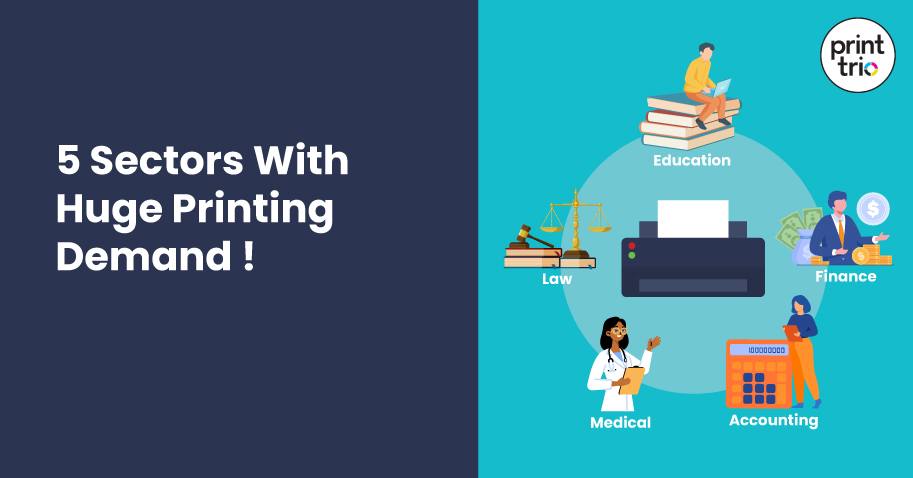The print industry plays a crucial role in our daily lives. Most citizens rely on written documentation. In addition to being an essential sector, the industry also supports residents, cultures, and education in some way through the products it produces. This support is currently in peril due to the disruptions occurring in the supply chain.
Overview of The Print Industry
The printing industry is responsible for more than a hundred life-sustaining activities, including information flow, the entertainment industry, educational institutions, and the advertising and packaging industries. Despite playing a crucial role in all facets of life, the significance of print in everyday life is sometimes underrated. Our industry produces the packaging for groceries sold in supermarkets as well as the packaging for the books, newspapers, and magazines that people like us read. In addition, there are eCommerce boxes, which give food, clothing, electronics, and a great deal more 24 hours a day, seven days a week.
A large number of paper businesses have reduced their capacity during the past two years by either moving to product packaging grades or shutting down plants. Despite all of this, the rise of the food, pharmaceutical, and internet retail industries is being driven by the demand for boxes. The inability to print will result in substantial economic losses. It will have a negative effect not just on the printing company‘s balance sheet but also on the customer in the end. The majority of firms have suffered an increase in the cost of all commodities and inputs, and this increase will ultimately be borne by the final consumers. As a result of the global shortage of important paper types, the industry’s leading printers and package converters have begun informing their customers of the looming paper crisis.
In the past two years, there has been a general decline in the market for printed products, suggesting that demand has returned to pre-pandemic levels. The increase in demand can be linked to “the economy regaining its footing” and the openness of the school system. The current degree of market volatility is unprecedented. As a result of the crisis in Ukraine, the situation has deteriorated, posing severe supply issues for enterprises who manufacture forest-based products and obtain their wood or pulp from either Russia or Ukraine.
Economic Side Of Printing Industry
In the interim, economic expansion has persisted. This shows that there is an increase in demand for paper and other packaging materials. As long as online shopping is as popular as it is today, the demand for virgin boards and kraft will undoubtedly continue to climb. The price increase is due, among other things, to increases in the costs of market pulps, chemicals, coal, and shipping freight.
These increases in the prices of raw materials have had a global impact and have had ramifications for every paper supplier on the planet. I have the sense that certain paper manufacturers provide a substandard product since they have not updated their facilities with the most modern gear. This influences both the amount of time and the cost of labour. Moreover, these concerns have not prevented Indian paper manufacturers from exporting their goods. This is especially true for kraft paper, which is required for the creation of corrugated or brown boxes, which are used in the packaging of commodities such as consumer electronics, farm produce, and fast-moving consumer goods (FMCG), and which are utilised in daily life.
Sectors With The Highest Paper Printing Demand
Education
There is substantial use of paper in all educational institutions. An average school consumes 360 000 sheets of paper annually.
Given that there are over 131,000 schools in the United States, educators annually consume more than 47 billion sheets of paper.
When this figure is divided by the number of school days, the surprising result is that 262 million pages are consumed every school day in the United States alone.
The majority of homework assignments and class notes are delivered by lecturers as written assignments and handouts. The administrative aspect of schooling is also responsible for a substantial volume of paperwork.
Law
A single attorney will produce an average of sixty thousand pages every year.
This corresponds to an average of thirty pages every hour, or a startling 240 pages per day, assuming a forty-hour workweek.
This makes a great deal of sense when one considers the considerable administrative responsibilities that lawyers must deal with on a consistent basis and the need for documentation that these tasks foster.
Medical
The Medical sector is ranked third overall. A typical hospital with 1,500 beds produces more than 8 million pages every month.
This equates to a daily average of 178 printed pages per hospitalised patient. And this number includes only healthcare establishments such as hospitals.
The average worker in a medical office produces an additional 36.5 pages each day. Each day, the medical community as a whole generates an average of 214 pages of paperwork pertaining to individual patients.
This is not surprising when one considers the considerable amount of paperwork that must be performed for each patient, as well as the extensive research and educational criteria that must be accomplished within the medical industry. Due to the nature of the medical industry, which places patients’ lives in hazard, the liability risk is unusually high, and the presence of this risk justifies the need for voluminous administrative paperwork.
Accounting
Accounting follows closely after, with an average of 35,5 pages produced per user. The accounting profession involves a number of financial papers, including income and expense statements, balance sheets, and cash flow statements. Typically, these documents are printed either before or after they are digitally filled out.
Accountants are obligated to print various administrative documents when working with clients. According to CPC Office Technologies’ estimations, 17 percent of all printed content is never used again after it has been printed.
Finance
The average number of pages printed by Finance industry users is 20,2, placing it in second position behind the Accounting industry. The majority of financial institutions do not anticipate a reduction in paper consumption within the next two years.
Similar to accounting, finance involves a substantial volume of printed documents in addition to administrative documentation.
Dangers Holding The Print Industry
In response to a fall in demand for commercial printing, the international packaging and printing industry faces higher levels of competition. The surprise overnight increase in prices, which was not conveyed to clients beforehand, may prove to be the fatal blow. The printers place their order based on the prevalent market rates for the raw material at the time they make the reservation, but the rates alter when they actually make the purchase during the production process.
Understanding all of the elements that govern the paper industry indicates that even relatively minor shifts in market conditions can have a considerable effect on the supply and demand of paper as well as the global price of paper. The market for pulp and paper is influenced by all of the aforementioned factors, which all have a role in determining the overall price and availability of products. For many years to come, these forces will continue to have an effect on the sector. Due to the fact that geopolitical events can sometimes abruptly affect the environment, it is essential to prepare to be a backup supplier in case an unplanned crisis disrupts the supply chain. Even while there may be significant price increases in the next six months for all types of paper for printing due to the expense of pulp, the good news is that paper experts and analysts anticipate a price levelling out in the near future. Despite the prospect of more price hikes, this is the case.


5 Sectors With Huge Printing Demand